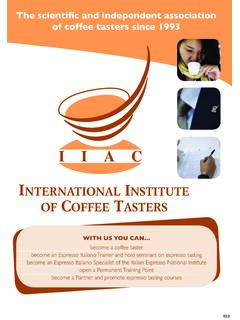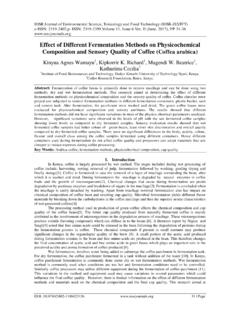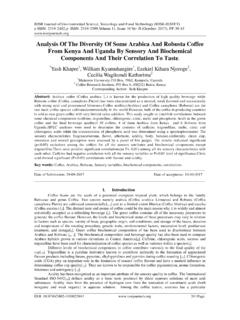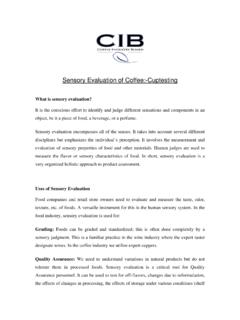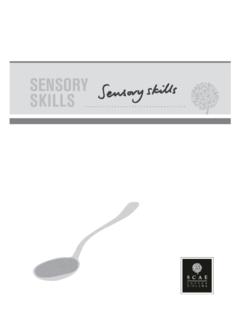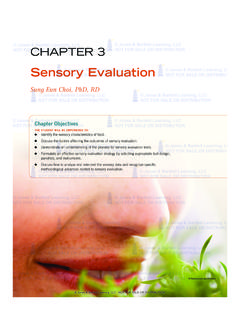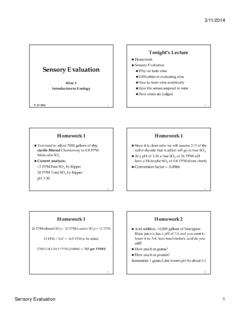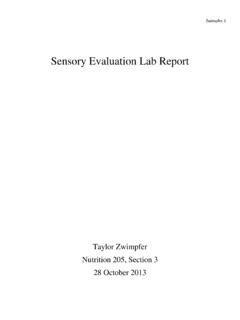Transcription of SENSORY FOUNDATION - Home - Mumac Academy
1 2 SENSORY FOUNDATION BLOOMS TAXONOMY: Remembering / Understanding. SUB CODE KNOWLEDGE/SKILL REQUIRED STANDARDS REFERENCE THEORETICAL PRINCIPLES WHAT IS SENSORY ANALYSIS A scientific discipline that evokes, measures, analyses and interprets reactions to those characteristics of foods and materials as they are perceived by the senses of sight, smell, taste, touch and hearing It relies on trained and regular tasters, standardised preparation protocol and questionnaire, decision rules Give examples during training including.
2 Touch wool samples Sight optical illusions Identify different senses Recognise that SENSORY analysis in coffee requires a standard protocol L1 Meilgaard, M & Co (1999) SENSORY evaluation technicques. 3rd Edition, CRC Press LLC, Boca Raton, FL Lawless and Heymann (2011), 2nd Edition, if the references are to be made to baristas. It is the most recent and up-to-date regarding current knowledge and practices. Carpenter, & Co. (2000) Guidelines for SENSORY Analysis in Food Product Development and Quality Control.
3 2nd Edition. Aspen Publishers, Gaithersburg, MD WHY IS SENSORY IMPORTANT IN coffee Cupping seeks to: identify potential defects and taints identify pleasant flavours and their quality evaluate intensity record the results It establishes a general picture of a coffee s potential that can be refined and adjusted to various blending and brewing practices Technic widely used in food industry extended to others (car, pharma, ..), in the high gastronomy product. For QC, NPD, Premiumness evaluation L2 Mu oz, AM, Civille, GV and Carr, BT (1992).
4 SENSORY Evaluation In Quality Control. Van Nostrand Reinhold, New York Yantis, JE [Ed.] (1992) The Role of SENSORY Analysis in Quality Control. ASTM. West Conshohocken, PA Cup speciality vs non-speciality coffee Prove a is different to b Discuss different tastes in two coffees Try two speciality coffees and compare Acknowledge that the aim of SENSORY analysis in coffee is to be able to distinguish, recognise and distinguish between different attributes, whether we personally like them or not L2 Mu oz, AM, Civille, GV and Carr, BT (1992).
5 SENSORY Evaluation In Quality Control. Van Nostrand Reinhold, New York Yantis, JE [Ed.] (1992) The Role of SENSORY Analysis in Quality Control. ASTM. West Conshohocken, PA 3 SUB CODE KNOWLEDGE/SKILL REQUIRED STANDARDS REFERENCE PHYSIOLOGY AND SENSORY ATTRIBUTES PHYSIOLOGY Olfaction and gustation are the two key senses used in coffee cupping Taste buds in the mouth Not all papillae have taste buds Flavour is a multi-modal experience: integrating gustatory, retronasal olfaction and somatosensory systems In training use a sugar flavoured with cinnamon or vanilla and do the pinch test on nose L1 Meilgaard Handbook of olfaction and gustation Edited by Richard L Doty (1995) Distinguish the difference between taste and flavour Recognise that taste exists in the oral cavity Recognise that flavour is primarily driven by the olfactory bulb L1 Meilgaard Handbook of olfaction and gustation.
6 Edited by Richard L Doty (1995) BASIC TASTES There are 5 basic tastes All coffees are naturally acid, bitter and have a sweet perception (more than they are physically sweet) Speciality coffee is not expected to have too high a perceived saltiness Umami is not a taste usually associated with brewed coffee Relationship between individual sensations will vary depending on their individually perceived strength A group practical session before test in training shows 25% stronger solutions than the final test L2 ISO standard List the 5 basic tastes Identify the 5 basic tastes in a blind assessment Recognise differences in taste sensations between two coffees in the practical pairs
7 Test see L2 ISO standard BASIC AROMAS There are three main categories of aroma: Enzematic Sugar Browning Dry Distillation These aromas will be present in the dry fragrance through to the brewed coffee Carry out a simple category exploration as a group of enzematic, sugar browning and dry distillation. Use picture boards with aroma vials to make stronger cognitive links L1 Lingle coffee Cuppers Handbook 4 SUB CODE KNOWLEDGE/SKILL REQUIRED STANDARDS REFERENCE DETECTING SENSORIAL QUALITIES IN coffee DEFINE TASTES AND BODY IN coffee In coffee , basic tastes and aromas do not exist in isolation and they need to be recognised within the brewed coffee itself The body of the coffee describes the apparent viscosity, fullness and weight in the mouth ranging from "thin, watery" to "thick.
8 Heavy" Combine the basic tastes and aromas learned and apply recognition of these to pairs of different coffees Different coffees will have different perceived tastes and body L2 Identify the following key attributes in pairs of coffee : Acidity Bitterness Body Acknowledge that acidity, bitterness and body are origin and process dependent L2 DEFINE AROMAS IN coffee Recognise and categorise key positive aromas from coffee L2 Identify simple category differences in aroma groups in a practical blind test Recall aroma categories in a written test L2 COMMUNICATING THE RESULTS Cuppers use a consistent standardised language to aid communication between themselves L2 Recognise that standard terminology is used to aid clear communication Repeat key terms used in cupping.
9 Such as acidity and body. Mention astringency and balance (TBD in intermediate) Distinguish the difference between positive and negative key terms L2 CUPPING PROTOCOL WHAT IS CUPPING It is a SENSORY analysis process specific to coffee coffee cupping is a method used to systematically evaluate the aroma and taste characteristics of a sample of coffee beans (Ted Lingle 2001) L1 SCAA Lingle coffee Cuppers Handbook 5 SUB CODE KNOWLEDGE/SKILL REQUIRED STANDARDS REFERENCE Repeat a definition of cupping L1 SCAA Lingle coffee Cuppers Handbook KEY TERMINOLOGY/ SENSORY VOCABULARY Cupping coffee with: Eye: colour, froth, crema Nose: aroma categories (see point 5) Mouth.
10 Basic taste and mouthfeel L2 coffee Sensorial Analysis Vocabulary ISO TC 34/SC 15N 2113 Group example comparing milk and water to show mouthfeel L2 coffee Sensorial Analysis Vocabulary ISO TC 34/SC 15N 2113 CORE CUPPING PROTOCOL Set out the standard procedure for preparing and brewing a cupping session Define the correct brew ratios Define the key protocol terms: Dry Crust Break L1 SCAA Lingle coffee Cuppers Handbook Memorise and repeat the standard process of setting up a cupping batch Define key terms used in a cupping session Recall standard measurements and protocol in a written test L1 SCAA Lingle coffee Cuppers Handbook EQUIPMENT AND MAINTENANCE CORE SENSORY EQUIPMENT Define core equipment for coffee SENSORY analysis Understand the importance of hygienic odour-free work space for cupping L1 Identify equipment that is necessary or
